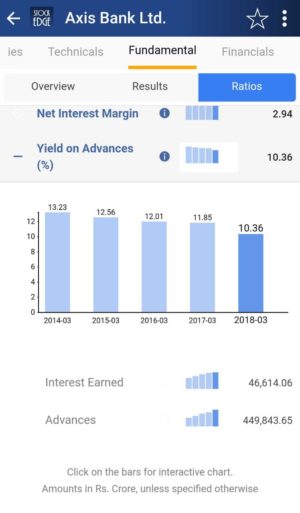Table of Contents

Banks are differently analyzed using a different kind of ratios to determine the strength in their lending and borrowing books. Thus Yield on advances is one such ratio which is calculated for the banks and NBFC’s. Financial ratios are an important tool in deciding the investment rationale behind any company. There are a lot of ratios such as PE ratio, Net profit margin, interest coverage ratio etc. used for the valuation of a company. Banks are quantified under different ratios like NIM’s, NPA’s, Provision coverage ratio, CASA ratio etc. Let’s understand in detail.
Impact of yield on advances
The average yield on investment results from adding all interests, dividend or other income generated from the investments divided by the average of the investments for the year. The average annual yield on an investment is a useful tool for floating rate investments, in which the fund’s balance and/or the interest rate changes frequently. The higher banks and financial institutions’ loan to asset ratio, the higher is its yield on returning assets. This is because higher-yielding vehicles bring in more income relative to the amount of money on loan.
See also: Net Interest Margin (NIM)
You can also watch the below video to know more:
What is the Yield on advances formula?
YOA= Interest earned/Advances
Suppose a company earns interest of Rs 10 lac and the advances are 25 lac, then its yield on advances is 10/25 or 40%.

Frequently Asked Questions
What is yield on advance?
Banks are differently analyzed using a different kind of ratios to determine the strength in their lending and borrowing books. It is one such ratio which is calculated for the banks and NBFC’s. The ratio gives the average lending rate of the portfolio. High yield on advances is an indication that the entity is into financing riskier assets and may see asset quality issues. It also indicates whether the pricing of the loan is in line with underlying risk.u003cbru003e
Know the formula
Formula for yield on advances = Interest income/Average advances. Suppose a company earns interest of Rs.20 lacs and the advances is Rs.50 lacs, then its yield on advances is 20/50 or 40%.
What is yield on advances ratio?
The yield on advances ratio gives the average lending rate of the portfolio. High yield on advances is an indication that the entity is into financing riskier assets and may see asset quality issues. It also indicates whether the pricing of the loan is in line with underlying risk.
StockEdge App
Nowadays we don’t have to calculate Yield on advances on our own. StockEdge gives us Yield on advances of the last year of any company listed in the stock exchange. We can look and compare Yield on advances of any NBFC’s and Banks and filter out stocks accordingly.
Suppose we want to look at the Yield on advances of Axis bank of last year. In the Fundamental tab of Axis bank, click on the fundamentals tab, we will get the Ratios tab. Then in the Ratios tab click on Return Ratios, and we get the Yields on advances in a minuscule of a second.
Bottomline
Yield on Advances is an important parameter to understand if the bank or NBFC is able to generate good returns on its loans. With the help, these ready-made parameters you can with the click of a button filter out YoA of every bank. So what are you waiting for? These parameters are freely available in every Banks and NBFC under StockEdge app. So, don’t wait anymore, if you still do not have the StockEdge app, download this effective stock market analysis tool right now to use this feature for free.
Click here to know more: Stockedge Premium









